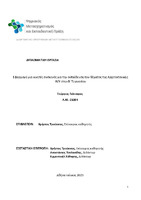| dc.contributor.advisor | Troussas, Christos | |
| dc.contributor.author | Γιάνναρος, Γιώργος | |
| dc.date.accessioned | 2023-07-13T10:31:02Z | |
| dc.date.available | 2023-07-13T10:31:02Z | |
| dc.date.issued | 2023-06-30 | |
| dc.identifier.uri | https://polynoe.lib.uniwa.gr/xmlui/handle/11400/4653 | |
| dc.identifier.uri | http://dx.doi.org/10.26265/polynoe-4491 | |
| dc.description.abstract | Στο πλαίσιο αυτής της διπλωματικής εξετάσαμε εάν η εφαρμογή με τίτλο Αρχιτεκτονική
Υπολογιστών (computer architecture) για κινητές συσκευές εκπαίδευσε τους μαθητές της Β’
Γυμνάσιου για θέματα της αρχιτεκτονικής Η/Υ της πληροφορικής. Υλοποιήθηκε στα πλαίσια
του μαθήματος «Πληροφορική» της Β’ Γυμνασίου και αξιολογήθηκε από τους καθηγητές που
έχουν σχέση με το αντικείμενο. Οι τεχνολογίες και οι θεωρίες που χρησιμοποιήθηκαν είναι
μάθηση μέσω κινητών συσκευών (mobile learning), μοντέλο μάθησης κατά Bloom,
εκπαίδευση από απόσταση ασύγχρονα και παιχνιδιoποίηση δηλαδή παιχνίδι επίλογων με
επίπτωση. Η εφαρμογή βασίστηκε στο μοντέλο μάθησης κατά Bloom και περιλαμβάνει 3
στάδια:
1. θεωρία όσον αφορά την αρχιτεκτονική Η/Υ.
2. Ένα παιχνίδι εικονικής κατασκευής υπολογιστή όπου ο μαθητής θα επιλέγει τα
διάφορα μέρη του υπολογιστή σε σχέση επίδοσης κόστους.
3. Ασκήσεις αξιολόγησης που θα αφορούν την αρχιτεκτονική Η/Υ.
Η εφαρμογή αυτή έχει σκοπό να λειτουργήσει παράλληλα με τον παραδοσιακό τρόπο
εκπαίδευσης όπου ο μαθητής εκπαιδεύεται στο σχολείο με την φυσική του παρουσία και θα
λειτουργεί σαν επιπρόσθετη βοήθεια για τους μαθητές. Όσον αφορά την αξιολόγηση της
εφαρμογής, τα αποτελέσματα έδειξαν ότι η εφαρμογή τελικά μπορεί να εκπαιδεύσει τους
μαθητές ως προς τους στόχους για την οποία φτιάχτηκε. Εκτελέστηκε μέχρι το τέλος από
όλους σχεδόν τους αξιολογητές και η πλειοψηφία απάντησε ότι η εφαρμογή τους ήταν
χρήσιμη. | el |
| dc.format.extent | 54 | el |
| dc.language.iso | el | el |
| dc.publisher | Πανεπιστήμιο Δυτικής Αττικής | el |
| dc.publisher | Εθνικό και Καποδιστριακό Πανεπιστήμιο Αθηνών | el |
| dc.publisher | Ανώτατη Σχολή Παιδαγωγικής και Τεχνολογικής Εκπαίδευσης (Α.Σ.ΠΑΙ.Τ.Ε.) | el |
| dc.rights | Αναφορά Δημιουργού - Μη Εμπορική Χρήση - Παρόμοια Διανομή 4.0 Διεθνές | * |
| dc.rights | Attribution-NonCommercial-NoDerivatives 4.0 Διεθνές | * |
| dc.rights.uri | http://creativecommons.org/licenses/by-nc-nd/4.0/ | * |
| dc.subject | Μάθηση μέσω κινητών συσκευών | el |
| dc.subject | Μοντέλο μάθησης κατά Blood | el |
| dc.subject | Εκπαίδευση από απόσταση ασύγχρονα | el |
| dc.subject | Παιχνιδιoποίηση | el |
| dc.subject | Computer architecture | el |
| dc.subject | Ηλεκτρονική μάθηση | el |
| dc.title | Εφαρμογή για κινητές συσκευές για την εκπαίδευση του θέματος της Αρχιτεκτονικής Η/Υ στην Β ’Γυμνασίου | el |
| dc.title.alternative | Application for mobile devices for the education of the topic of Computer Architecture in the second grade | el |
| dc.type | Μεταπτυχιακή διπλωματική εργασία | el |
| dc.contributor.committee | Τσολακίδης, Αναστάσιος | |
| dc.contributor.committee | Χάλαρης, Εμμανουήλ | |
| dc.contributor.faculty | Σχολή Μηχανικών | el |
| dc.contributor.department | Τμήμα Μηχανικών Πληροφορικής και Υπολογιστών | el |
| dc.contributor.master | Ψηφιακός Μετασχηματισμός και Εκπαιδευτική Πράξη | el |
| dc.description.abstracttranslated | In the context of this thesis we examined whether the application entitled Computer architecture for
mobile devices educated the second-grade students in computer architecture issues in computer
science. It was implemented in the context of the course "Computer Science" of the second-grade
and was evaluated by the teachers related to the subject. The technologies and theories used are
mobile learning, Bloom's model of learning, distance learning asynchronously and gamification i.e.
game play with implication. The application was based on the Bloom learning model and includes 3
stages:
1. theory in terms of computer architecture,
2. A virtual computer building game where the student will select the different parts of
the computer in relation to cost performance.
3. Finally evaluation exercises that will be related to computer architecture.
This application is intended to work alongside the traditional way of education where the
student is trained in the school with his/her physical presence and will act as an additional
help for the students. Regarding the evaluation of the app, the results showed that the app
can finally educate students towards the goals for which it was built. It was run to the end by
almost all the evaluators and the majority responded that their app was useful. | el |


